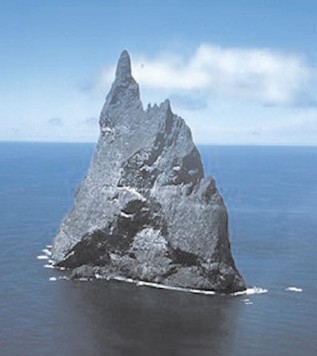By paffy on May 15, 2013 Category: Pics, Travel
 Ball's Pyramid seen from the air. | |
| Elevation | 562 m (1,844 ft) |
|---|---|
| Location | |
| Location | Australia |
| Range | Lord Howe Island Group |
| Geology | |
| Type | Volcanic plug |
| Age of rock | less than 7 million years |
| Volcanic arc/belt | Lord Howe seamount chain |
| Last eruption | Unknown |
| Climbing | |
| First ascent | 1965 |
| Easiest route | Boat overseas |
Ball's Pyramid is an erosional remnant of a shield volcano and caldera that formed about 7 million years ago. Ball's Pyramid is 20 kilometres (12 mi) southeast of Lord Howe Island in the Pacific Ocean. It is 562 metres (1,844 ft) high, while measuring only 1,100 metres (3,600 ft) in length and 300 metres (980 ft) across, making it the tallest volcanic stack in the world.[1] Ball's Pyramid is part of the Lord Howe Island Marine Park in Australia.
Ball's Pyramid has a few satellite islets. Observatory Rock and Wheatsheaf Islet lie about 800 metres (2,600 ft) west-northwest and west-southwest respectively, of the western extremity of Ball's Pyramid. Southeast Rock is a pinnacle located about 3.5 kilometres (2.2 mi) southeast of Ball's Pyramid. Like Lord Howe Island and the Lord Howe seamount chain, Ball's Pyramid is based on the Lord Howe Rise, part of the submerged continent of Zealandia.
History [edit]
The pyramid was named after Lieutenant Henry Lidgbird Ball, who discovered it in 1788 on the same trip as when he discovered Lord Howe Island. The first person to go ashore is believed to have been Henry Wilkinson in 1882, who was a geologist at the New South Wales Department of Mines.
The first successful climb to the summit was made on 14 February 1965 by a team of climbers from the Sydney Rock Climbing Club, consisting of Bryden Allen, John Davis, Jack Pettigrew and David Witham.[2] There had been an earlier attempt in 1964 by another Sydney team, which included adventurer Dick Smith and other members of the Scouting movement. They were forced to turn back on their fifth day, running short of food and water. In 1979, Smith returned to the pyramid, together with climbers John Worrall and Hugh Ward. They successfully reached the summit and unfurled a flag of New South Wales provided to them by Premier Neville Wran, declaring the island Australian territory (a formality which it seems had not previously been done).
Climbing was banned in 1982 under amendments to the Lord Howe Island Act, and in 1986, all access to the island was banned by the Lord Howe Island Board. In 1990, the policy was relaxed to allow some climbing under strict conditions, which in recent years has required an application to the relevant state Minister.[3]
Fauna [edit]
Main article: Dryococelus australis
In 2001, a team of entomologists and conservationists landed on Ball's Pyramid to chart its flora and fauna. As they had hoped, they discovered a population of the Lord Howe Island stick insect (Dryococelus australis) living in an area of 6 by 30 metres (20 by 98 ft), at a height of 100 metres (330 ft) above the shoreline, under a single Melaleuca howeana shrub. The bush was growing in a small crevice where water was seeping through cracks in the underlying rocks. This moisture supported relatively lush plant growth which had, over time, resulted in a build up of plant debris, several metres deep. The population was extremely small, only 24 individuals. Two pairs were brought to two Pacific zoos to breed new populations.[4] On the unsuccessful 1964 climb, Dave Roots brought back a photograph of the insect, which the Australian Museum told him they thought was extinct.
No comments:
Post a Comment